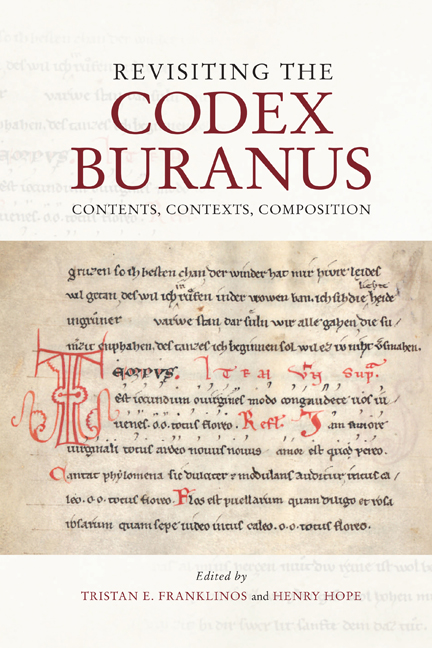Book contents
- Frontmatter
- Contents
- List of Illustrations
- Acknowledgements
- Abbreviations
- Dedication
- Introduction: The Codex Buranus – A Unique Challenge
- Chapter 1 A Modern Reception History of the Codex Buranus in Image and Sound
- Chapter 2 Parody in the Codex Buranus
- Chapter 3 Satire in the Codex Buranus
- Chapter 4 ‘Artes Amatorie Iam Non Instruuntur’: Learned and Erotic Discourse in the Carmina Burana
- Chapter 5 Classical Learning and Audience in the Carmina Amatoria: A Case-Study on CB 92
- Chapter 6 Rape, the Pastourelle, and the Female Voice in CB 185
- Chapter 7 Rethinking the Carmina Burana III: The Poetry of Peasants
- Chapter 8 Predestination and God’s Grace: The Salvific Architecture of the Religious Songs in the Codex Buranus
- Chapter 9 Revisiting the Plays of the Codex Buranus
- Chapter 10 Revisiting the Music of the Codex Buranus
- Chapter 11 Locating the Codex Buranus: Notational Contexts
- Chapter 12 Plurilingualism in the Codex Buranus: An Intercultural Reconsideration
- Chapter 13 Compilation, Contrafacture, Composition: Revisiting the German Texts of the Codex Buranus
- Afterword: multiformis armonia, scolaris symphonia
- List of Manuscripts
- Bibliography
- Index
- General Index
- Studies in Medieval and Renaissance Music
Chapter 11 - Locating the Codex Buranus: Notational Contexts
Published online by Cambridge University Press: 16 September 2020
- Frontmatter
- Contents
- List of Illustrations
- Acknowledgements
- Abbreviations
- Dedication
- Introduction: The Codex Buranus – A Unique Challenge
- Chapter 1 A Modern Reception History of the Codex Buranus in Image and Sound
- Chapter 2 Parody in the Codex Buranus
- Chapter 3 Satire in the Codex Buranus
- Chapter 4 ‘Artes Amatorie Iam Non Instruuntur’: Learned and Erotic Discourse in the Carmina Burana
- Chapter 5 Classical Learning and Audience in the Carmina Amatoria: A Case-Study on CB 92
- Chapter 6 Rape, the Pastourelle, and the Female Voice in CB 185
- Chapter 7 Rethinking the Carmina Burana III: The Poetry of Peasants
- Chapter 8 Predestination and God’s Grace: The Salvific Architecture of the Religious Songs in the Codex Buranus
- Chapter 9 Revisiting the Plays of the Codex Buranus
- Chapter 10 Revisiting the Music of the Codex Buranus
- Chapter 11 Locating the Codex Buranus: Notational Contexts
- Chapter 12 Plurilingualism in the Codex Buranus: An Intercultural Reconsideration
- Chapter 13 Compilation, Contrafacture, Composition: Revisiting the German Texts of the Codex Buranus
- Afterword: multiformis armonia, scolaris symphonia
- List of Manuscripts
- Bibliography
- Index
- General Index
- Studies in Medieval and Renaissance Music
Summary
From its inception, the Codex Buranus was intended as a collection of songs and verse. While a few metrical uersus are included among the more typical lyric texts, the rhythmi, it is evident that the manuscript's lineation was designed to allow space above the words for musical signs, now traditionally called neumes, to be added later. Even when the texts were copied, the music must have been in the mind of the scribe – if not in an exemplar – as blank space was left for melismas, the long melodies sung to a single syllable. Though the Codex Buranus offers evidence of an intentional planning of its contents, it was also a work in progress: many details are left unfinished, as seen in the missing initials, the many corrections, and especially the addition of the musical notation. Only fifty songs in the manuscript's present state have neumatic notation, added with varying degrees of completeness, and a further nineteen songs have music only in concordant manuscripts.
One persistent question in research on the Codex Buranus has been that of its provenance, which initially was examined most closely from philological and palaeographical perspectives. From the Italianisms in the Latin texts to the regional dialect of German, the linguistic properties reveal that the Codex Buranus was most likely copied in a culturally rich border region. Attempts to locate the provenance of the Codex Buranus have been a changing refrain in scholarship on the manuscript. These studies could form a medieval Baedeker guide to South Bavaria, Styria, Carinthia, and the South Tyrol and the cultural institutions that may have provided the context and resources to produce this manuscript.
An examination of the musical notation in the Codex Buranus has not been a critical factor in these earlier discussions of provenance. Following Otto Schumann's analysis in the 1930 commentary to Hilka/Schumann, Heike Sigrid Lammers's 1997 dissertation was the first detailed investigation of the manuscript's neumes and raised significant questions concerning some received opinions, but did not address the question of provenance.
- Type
- Chapter
- Information
- Revisiting the Codex BuranusContents, Contexts, Compositions, pp. 283 - 316Publisher: Boydell & BrewerPrint publication year: 2020



